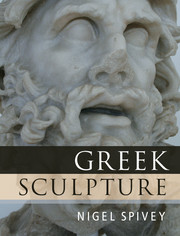Book contents
- Frontmatter
- Dedication
- Contents
- List Of Figures
- Preface
- Note
- 1 Introduction: the Study Of Greek Sculpture
- 2 The Greek Revolution
- 3 Daedalus and the Wings of Technê
- 4 Anathêmata: Gifts for the Gods
- 5 Heroes Apparent
- 6 Temple Stories
- 7 In Search of Pheidias
- 8 Revealing Aphrodite
- 9 Royal Patronage
- 10 Portraits and Personifications
- 11 Graecia Capta
- 12 Afterlife
- Index
9 - Royal Patronage
Published online by Cambridge University Press: 01 December 2014
- Frontmatter
- Dedication
- Contents
- List Of Figures
- Preface
- Note
- 1 Introduction: the Study Of Greek Sculpture
- 2 The Greek Revolution
- 3 Daedalus and the Wings of Technê
- 4 Anathêmata: Gifts for the Gods
- 5 Heroes Apparent
- 6 Temple Stories
- 7 In Search of Pheidias
- 8 Revealing Aphrodite
- 9 Royal Patronage
- 10 Portraits and Personifications
- 11 Graecia Capta
- 12 Afterlife
- Index
Summary
The lengths to which an artistmay go in quest of a commission have never, perhaps, exceeded the effort of Dinocrates the Macedonian, who, ‘confident of his own ideas and skill’, sought to present himself to the attention of Alexander the Great. Having attempted all the usual formalities of gaining court access, Dinocrates decided to capitalize upon his own powerful physique. He anointed himself with oil, placed a wreath on his head and a lionskin over his shoulders; then, brandishing a knotty club, he walked prominently in front of a law tribunal where Alexander was giving judgement. Semi-naked, attired as a second Herakles, Dinocrates could hardly fail to be noticed. Alexander duly beckoned him over to explain himself:
I am Dinocrates, a Macedonian architect: I come with ideas and plans worthy of your majesty. Look, I have shaped Mount Athos itself into the statue of a man, whose left hand cradles the ramparts of a substantial city; in his right hand he holds a bowl, to catch all the waters of the rivers running down from the mountain.
According to our Latin source for this episode (Vitr. De Arch. 2.1–4), Alexander is delighted by this proposal, perhaps foreseeing that the statue could be made in his own image. But a practical objection strikes him. How will the city's corn supply be provided? There is no satisfactory answer to this problem, so the Mount Athos project is stalled. However, Dinocrates is taken into royal service – and eventually entrusted with the layout of Alexander's eponymous city in the Nile Delta.
As we shall see, Alexandria – especially as it flourished under Alexander's former general Ptolemy and his successors – became a model centre of royal patronage in the Graeco-Roman world (even if it was, strictly speaking, Macedonian-Egyptian). Meanwhile, the nature of the proposal gives us a useful index of what it takes to please a holder of absolute power. Vanity, megalomania, quasi-divine omnipotence and paternalism: all these are satisfied by the Mount Athos design. The contrast with the self-effacing decorum of Classical Greek democracies could hardly be greater.
As for the scale of the idea, it was, we may say, in keeping with the spirit of the age.
- Type
- Chapter
- Information
- Greek Sculpture , pp. 216 - 247Publisher: Cambridge University PressPrint publication year: 2013



